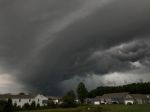How do demographers forecast population growth?
By Jeremy Singer-Vine
The global Muslim population will grow twice as fast as the non-Muslim population over the next 20 years, according to a report from the Pew Research Center and the John Templeton Foundation published on Thursday. During the same time period, the American Muslim population will more than double. How do demographers come up with these numbers?
Using the “cohort-component” method. In almost every serious population forecast, demographers first slice a given population into tranches, such as women ages 20 to 24 and men ages 65 to 69. Then they issue separate forecasts for each, typically using just three variables: fertility rate (how many children women have), mortality rate (what proportion of the population dies per year), and migration. Usually, demographers will calculate a range of scenarios for each variable—for instance, the highest and lowest plausible fertility rates over the next, say, 20 years. Finally, they synthesize the sub-forecasts into a range of likely trends, which they often present as “high,” “medium,” and “low” estimates.
Population forecasts are generally quite accurate. Country-level forecasts, such as those made by the United Nations and the World Bank, miss the mark by about 6 percent on average. (The U.N. has been projecting population growth at a global and regional level since the 1950s, and for most individual countries since shortly thereafter.) There’s been remarkably little change in most demographers’ techniques over the past century, so accuracy is mostly a function of how good (and how current) the underlying fertility, mortality, and migration data are. A study from 1983 found that while neither U.N. predictions for developed countries nor the Census Bureau’s predictions for the U.S. population had improved, those in developing countries had become more accurate—likely because of more-detailed recordkeeping. A 2001 study found little change in the U.N.’s overall forecasting accuracy since 1950s; if anything, accuracy peaked in the 1970s and late 1980s. (In general, the most difficult continent to make predictions for has been Africa, while Europe has been the easiest.)
Population forecasting has been caught off-guard by a few big trends. The baby boom made demographers’ population projections look foolishly low in the wake of World War II. Then, they predicted the boom would last longer than it did; the so-called “baby bust” made forecasts from the mid-1950s look much too high. Demographers also didn’t anticipate how severely the spread of HIV through the developing world would increase mortality rates.
Story Compliments Of Slate.com
















